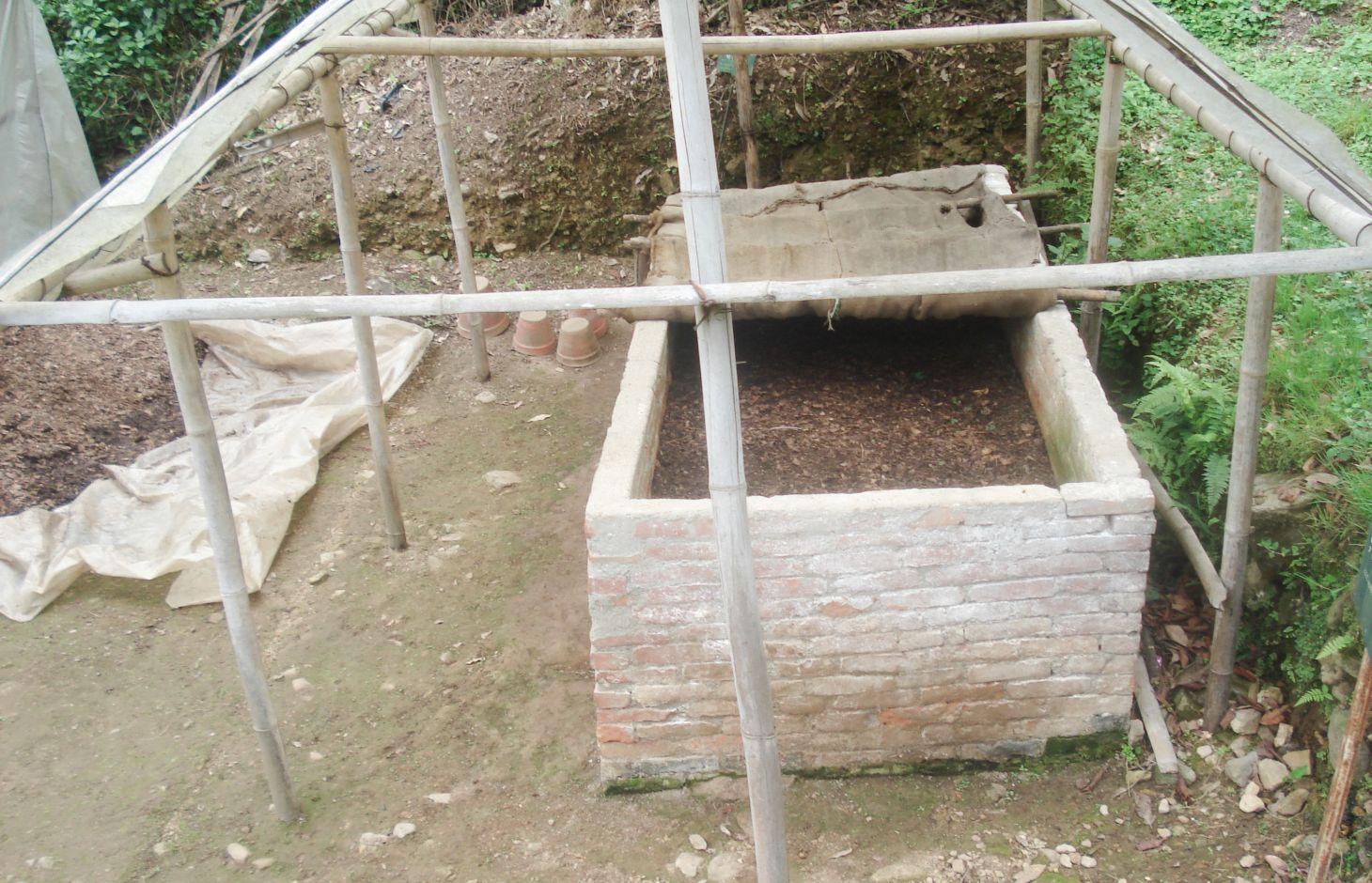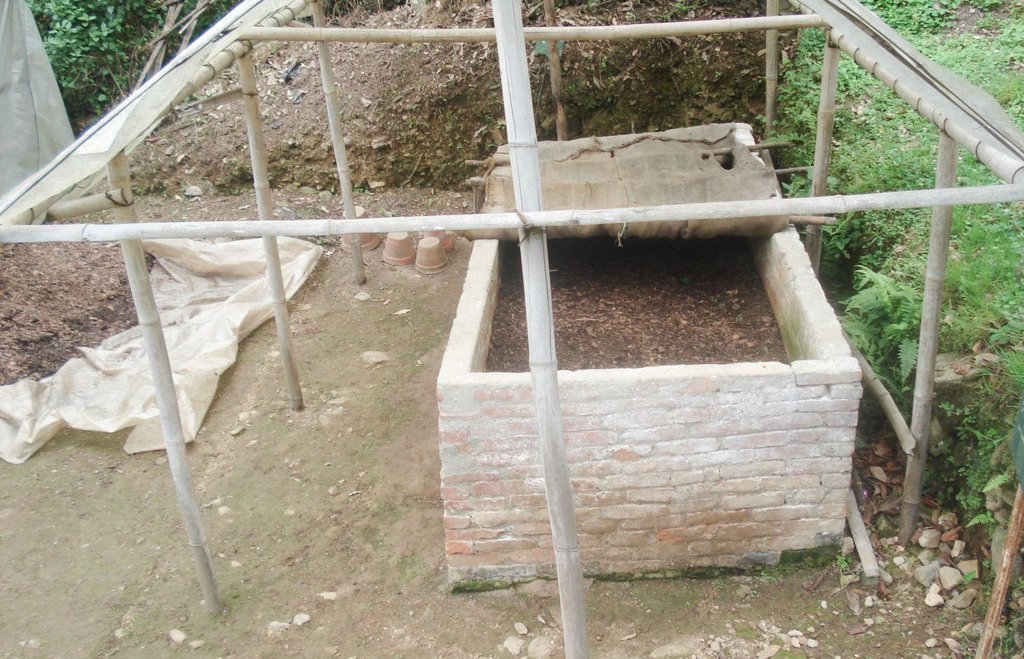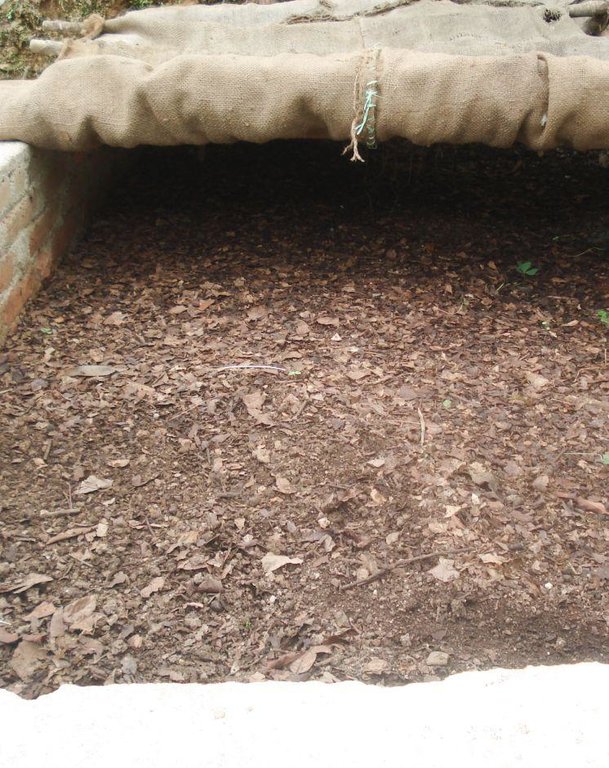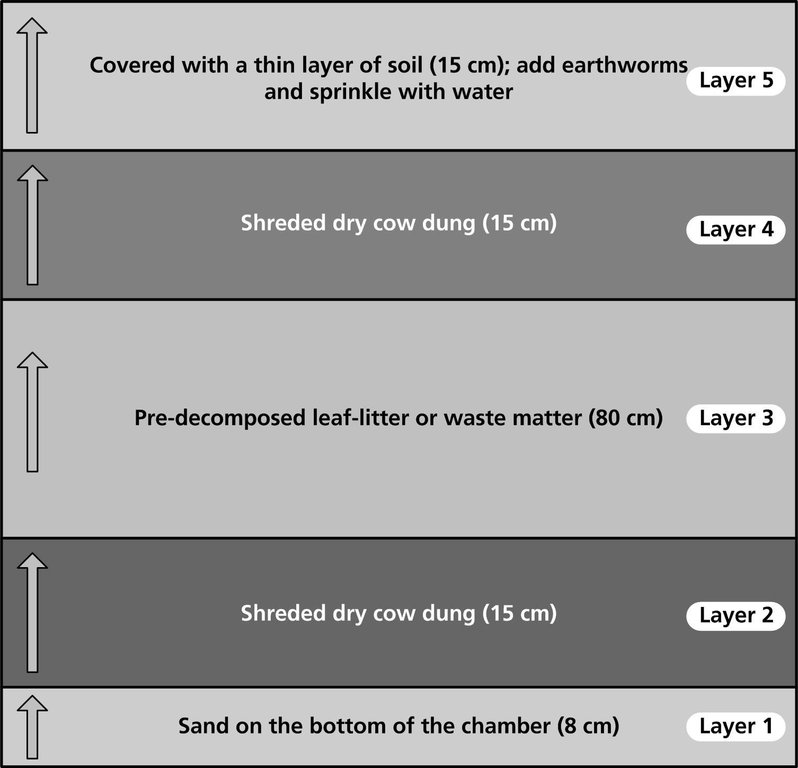Vermicomposting [Népal]
- Création :
- Mise à jour :
- Compilateur : Shreedip Sigdel
- Rédacteur : –
- Examinateurs : David Streiff, Alexandra Gavilano
Gadaula proyog gari mal banaune prabidhi (Main Contributor: Samden Sherpa, ICIMOD)
technologies_1695 - Népal
Voir les sections
Développer tout Réduire tout1. Informations générales
1.2 Coordonnées des personnes-ressources et des institutions impliquées dans l'évaluation et la documentation de la Technologie
Spécialiste GDT:
Sherpa Samden Lama
ICIMOD
Népal
Nom du ou des institutions qui ont facilité la documentation/ l'évaluation de la Technologie (si pertinent)
ICIMOD International Centre for Integrated Mountain Development (ICIMOD) - Népal1.3 Conditions relatives à l'utilisation par WOCAT des données documentées
Le compilateur et la(les) personne(s) ressource(s) acceptent les conditions relatives à l'utilisation par WOCAT des données documentées:
Oui
2. Description de la Technologie de GDT
2.1 Courte description de la Technologie
Définition de la Technologie:
Vermicomposting or worm composting is a simple technology for converting biodegradable waste into organic manure with the help of earthworms.
2.2 Description détaillée de la Technologie
Description:
Earthworms are valued by farmers because, in addition to aerating the soil, they digest organic matter and produce castings that are a valuable source of humus. Vermicomposting, or worm composting is a simple technology that takes advantage of this to convert biodegradable waste into organic manure with the help of earthworms (the red worm Eisenia foetida) with no pile turning, no smell, and fast production of compost. The earthworms are bred in a mix of cow dung, soil, and agricultural residues or predecomposed leaf-litter. The whole mass is converted into casts or vermicompost, which can be used as a fertilizer on all types of plants in vegetable beds, landscaping areas, or lawns.
Purpose of the Technology: Worms are so effective at processing organic waste that they can digest almost half their own weight in debris every day. Vermicomposting is a simple composting process that takes advantage of what earthworms do naturally, but confines the worms to bins making it easier for farmers to feed them and to harvest their nutrient-rich compost. Since all worms digest organic matter, in principle, any type of worm can be used; however, not all are equally well adapted to living in bins since some worms prefer to live deep in the soil while others are better adapted to living closer to the surface. The red worm (Eisenia foetida) is ideal for vermicomposting because its natural habitat is close to the surface and it is accustomed to a diet rich in organic matter, this makes it ideally suited to digesting kitchen scraps and to living in bins.
Establishment / maintenance activities and inputs: Vermicomposting can be carried out in different types of containers. There are only a few requirements for a good worm pit, the most important being good ventilation; the pit needs to have more surface area than depth (wide and shallow) and it needs to have relatively low sides. The base of the worm pit is prepared with a layer of sand then alternating layers of shredded dry cow dung and degradable dry biomass and soil are added. Under ideal conditions, 1,000 earthworms can covert 45 kg of wet biomass per week into about 25 kg of vermicompost.
Natural / human environment: Worm castings contain five times more nitrogen, seven times more phosphorous, and eleven times more potassium than ordinary soil, the main minerals needed for plant growth. The vermicompost is so rich in nutrients that it should be mixed 1:4 with soil for plants to be grown in pots and containers. Vermicompost should not be allowed to dry out before using.
Note: This type of vermicomposting is sometimes referred to as 'Pusa' vermicomposting because it was popularized in South Asia by the Rajendra Agricultural University located in Pusa, Bihar, India.
2.3 Photos de la Technologie
2.5 Pays/ région/ lieux où la Technologie a été appliquée et qui sont couverts par cette évaluation
Pays:
Népal
Autres spécifications du lieu:
Godavari, Lalitpur District
Spécifiez la diffusion de la Technologie:
- appliquée en des points spécifiques ou concentrée sur une petite surface
2.7 Introduction de la Technologie
Spécifiez comment la Technologie a été introduite: :
- au cours d'expérimentations / de recherches
- par le biais de projets/ d'interventions extérieures
3. Classification de la Technologie de GDT
3.1 Principal(aux) objectif(s) de la Technologie
- Improve fertilizer
3.2 Type(s) actuel(s) d'utilisation des terres, là où la Technologie est appliquée

Terres cultivées
- Cultures annuelles
- Cultures pérennes (non ligneuses)

Forêts/ bois
Produits et services:
- Bois de chauffage
- Pâturage/ broutage
Commentaires:
Major land use problems (compiler’s opinion): Crop productivity is limited by poor soil fertility, intense cropping, and a scarcity of irrigation water. Farmers notice a marked decrease in the health of their crops and degraded soil conditions when chemical fertilizers are overused. Vermicomposting is a low input response to this problem.
Forest products and services: fuelwood
Other forest products and services: fodder
3.5 Groupe de GDT auquel appartient la Technologie
- gestion intégrée de la fertilité des sols
- gestion des déchets/ gestion des eaux usées
3.6 Mesures de GDT constituant la Technologie

pratiques agronomiques
- A2: Matière organique/ fertilité du sol
3.7 Principaux types de dégradation des terres traités par la Technologie

dégradation chimique des sols
- Cn: baisse de la fertilité des sols et réduction du niveau de matière organique (non causée par l’érosion)
Commentaires:
Main causes of degradation: soil management
3.8 Prévention, réduction de la dégradation ou réhabilitation des terres dégradées
Spécifiez l'objectif de la Technologie au regard de la dégradation des terres:
- prévenir la dégradation des terres
4. Spécifications techniques, activités, intrants et coûts de mise en œuvre
4.1 Dessin technique de la Technologie
Spécifications techniques (associées au dessin technique):
Establishing a vermicompost pit
Diagram showing the layers needed to set up a vermicompost pit. Note that the middle layer is the thickest; the worms start here and eat both upwards and downwards. It is best to house the pit under a thatched or plastic roof in order to shield it from excessive sunshine and rain.
Technical knowledge required for field staff / advisors: moderate
Technical knowledge required for land users: moderate
Main technical functions: increase in nutrient availability (supply, recycling,…), Improve Soil Fertility
Secondary technical functions: improvement of topsoil structure (compaction), Stabilizes that soil
Auteur:
AK Thaku
4.2 Informations générales sur le calcul des intrants et des coûts
Spécifiez la manière dont les coûts et les intrants ont été calculés:
- par entité de la Technologie
Précisez l'unité:
worm pit
Précisez les dimensions de l'unité de terrain (le cas échéant):
A typical outdoor pit can measure 4 m long, 1 m wide and 0.75 m high
Indiquez la monnaie utilisée pour le calcul des coûts:
- dollars américains
4.3 Activités de mise en place/ d'établissement
| Activité | Calendrier des activités (saisonnier) | |
|---|---|---|
| 1. | A low cost pit can be constructed with bricks on a moist or shaded site | |
| 2. | If bricks are not available, stones can be used for the pit construction; | |
| 3. | alternatively, a wooden or bamboo box or a plastic tray can also be used. | |
| 4. | Vermicompost pits are best started during the summer months. | |
| 5. | A thatched roof was built over the pit to help retain moisture in the heap | |
| 6. | at a level of approximately 40–50%, as well as to maintain an optimal temperature of about 20–30oC. | |
| 7. | Sand, soil, cow dung, and leaf litter are piled up as shown in the diagram. | |
| 8. | Material Used are Bricks and cement, dry cow dung, plastic sheet/bamboo, earthworm (around 2000) |
4.4 Coûts et intrants nécessaires à la mise en place
| Spécifiez les intrants | Unité | Quantité | Coûts par unité | Coût total par intrant | % des coût supporté par les exploitants des terres | |
|---|---|---|---|---|---|---|
| Main d'œuvre | Construction of pit | persons/day/unit | 10,0 | 5,0 | 50,0 | |
| Matériaux de construction | Brick and cement | unit | 1,0 | 70,0 | 70,0 | |
| Matériaux de construction | Dry cow dung | unit | 1,0 | 10,0 | 10,0 | |
| Matériaux de construction | Plastic sheet/bamboo | unit | 1,0 | 70,0 | 70,0 | |
| Matériaux de construction | Earthworm (2000) | unit | 1,0 | 60,0 | 60,0 | |
| Coût total de mise en place de la Technologie | 260,0 | |||||
| Coût total de mise en place de la Technologie en dollars américains (USD) | 260,0 | |||||
Commentaires:
Duration of establishment phase: 3 month(s)
4.5 Activités d'entretien/ récurrentes
| Activité | Calendrier/ fréquence | |
|---|---|---|
| 1. | Water regularly and collect, harvest vermicompost | |
| 2. | The pit is watered regularly. After five to six weeks, the top layer is removed and piled in one corner of the pit. After a few days, the worms will have borrowed down to the bottom of this pile and the compost can be harvested. The compost prepared in the pit should be harvested within 6 months and the pit refurbished as for the first set as discussed above. |
4.6 Coûts et intrants nécessaires aux activités d'entretien/ récurrentes (par an)
| Spécifiez les intrants | Unité | Quantité | Coûts par unité | Coût total par intrant | % des coût supporté par les exploitants des terres | |
|---|---|---|---|---|---|---|
| Main d'œuvre | Watering pit | persons/day/unit | 5,0 | 5,0 | 25,0 | |
| Matériaux de construction | Dry cow dung | unit | 1,0 | 5,0 | 5,0 | |
| Matériaux de construction | Water pipe | unit | 1,0 | 10,0 | 10,0 | |
| Coût total d'entretien de la Technologie | 40,0 | |||||
| Coût total d'entretien de la Technologie en dollars américains (USD) | 40,0 | |||||
4.7 Facteurs les plus importants affectant les coûts
Décrivez les facteurs les plus importants affectant les coûts :
All costs and amounts are rough estimates by the technicians and authors. This was a demonstration project conducted by ICIMOD.
5. Environnement naturel et humain
5.1 Climat
Précipitations annuelles
- < 250 mm
- 251-500 mm
- 501-750 mm
- 751-1000 mm
- 1001-1500 mm
- 1501-2000 mm
- 2001-3000 mm
- 3001-4000 mm
- > 4000 mm
Zone agro-climatique
- subhumide
Thermal climate class: temperate
5.2 Topographie
Pentes moyennes:
- plat (0-2 %)
- faible (3-5%)
- modéré (6-10%)
- onduleux (11-15%)
- vallonné (16-30%)
- raide (31-60%)
- très raide (>60%)
Reliefs:
- plateaux/ plaines
- crêtes
- flancs/ pentes de montagne
- flancs/ pentes de colline
- piémonts/ glacis (bas de pente)
- fonds de vallée/bas-fonds
Zones altitudinales:
- 0-100 m
- 101-500 m
- 501-1000 m
- 1001-1500 m
- 1501-2000 m
- 2001-2500 m
- 2501-3000 m
- 3001-4000 m
- > 4000 m
5.3 Sols
Profondeur moyenne du sol:
- très superficiel (0-20 cm)
- superficiel (21-50 cm)
- modérément profond (51-80 cm)
- profond (81-120 cm)
- très profond (>120 cm)
Texture du sol (de la couche arable):
- moyen (limoneux)
Matière organique de la couche arable:
- abondant (>3%)
Si disponible, joignez une description complète du sol ou précisez les informations disponibles, par ex., type de sol, pH/ acidité du sol, capacité d'échange cationique, azote, salinité, etc.
Soil fertility is medium
Soil drainage / infiltration is medium
Soil water storage capacity is medium
5.4 Disponibilité et qualité de l'eau
Profondeur estimée de l’eau dans le sol:
< 5 m
Disponibilité de l’eau de surface:
bonne
Qualité de l’eau (non traitée):
eau potable
Commentaires et précisions supplémentaires sur la qualité et la quantité d'eau:
Water quality (untreated): Also for agricultural use (irrigation)
5.5 Biodiversité
Diversité des espèces:
- élevé
Commentaires et précisions supplémentaires sur la biodiversité:
695 species of flora and 230 species of fauna have been documented within the Park's 30 ha area
5.6 Caractéristiques des exploitants des terres appliquant la Technologie
Orientation du système de production:
- exploitation mixte (de subsistance/ commerciale)
Revenus hors exploitation:
- > 50% de tous les revenus
Niveau relatif de richesse:
- pauvre
Niveau de mécanisation:
- travail manuel
- traction animale
Indiquez toute autre caractéristique pertinente des exploitants des terres:
Population density: < 10 persons/km2
5.7 Superficie moyenne des terres utilisées par les exploitants des terres appliquant la Technologie
- < 0,5 ha
- 0,5-1 ha
- 1-2 ha
- 2-5 ha
- 5-15 ha
- 15-50 ha
- 50-100 ha
- 100-500 ha
- 500-1 000 ha
- 1 000-10 000 ha
- > 10 000 ha
5.8 Propriété foncière, droits d’utilisation des terres et de l'eau
- Governement
- ICIMOD
- ICIMOD
5.9 Accès aux services et aux infrastructures
routes et transports:
- pauvre
- modéré
- bonne
labour:
- pauvre
- modéré
- bonne
6. Impacts et conclusions
6.1 Impacts sur site que la Technologie a montrés
Impacts socio-économiques
Revenus et coûts
dépenses pour les intrants agricoles
charge de travail
Commentaires/ spécifiez:
The vermicompost pit needs to be watered and maintained regularly
Autres impacts socio-économiques
Earthworms need to be purchased from outside
Impacts socioculturels
livelihood and human well-being
Commentaires/ spécifiez:
Provides employment opportunities. Quality compost helps to improve the soil and increases crop production
Impacts écologiques
Autres impacts écologiques
soil fertility
can be used to produce organic crops
use of chemical fertilizer
6.2 Impacts hors site que la Technologie a montrés
dependency on external inputs
6.3 Exposition et sensibilité de la Technologie aux changements progressifs et aux évènements extrêmes/catastrophes liés au climat (telles que perçues par les exploitants des terres)
Autres conséquences liées au climat
Autres conséquences liées au climat
| Comment la Technologie fait-elle face à cela? | |
|---|---|
| active in warm climate | bien |
6.4 Analyse coûts-bénéfices
Quels sont les bénéfices comparativement aux coûts de mise en place (du point de vue des exploitants des terres)?
Rentabilité à court terme:
positive
Rentabilité à long terme:
positive
Quels sont les bénéfices comparativement aux coûts d'entretien récurrents (du point de vue des exploitants des terres)?
Rentabilité à court terme:
positive
Rentabilité à long terme:
positive
6.5 Adoption de la Technologie
Commentaires:
There is a strong trend towards spontaneous adoption of the Technology
Comments on adoption trend: Vermicomposting training was provided to farmers in Nuwakot, Rasuwa, Godavari, and Bishankhunarayan VDCs by ICIMOD staff in collaboration with local NGOs. More than 60% of the farmers who received training adopted vermicomposting on their own farms and they have also started selling worms to other farmers. The technology has been adopted by others who have visited the ICIMOD Knowledge Park at Godavari but most of these are just interested in introducing it on a small scale, such as, to produce vermicompost from kitchen waste for household use in their own gardens. The participants were also taught how to collect local earthworms to use for composting.
Drivers of adaptation of the technology
• A simple technology and easy to implement
• Local earthworms can be used.
• Not expensive; farmers can construct pits or uses wooden boxes or plastic trays.
• Produces high quality compost with a high concentration of nutrients
• Helps to reduce pests in the soil
• Can be scaled up to produce compost commercially
6.7 Points forts/ avantages/ possibilités de la Technologie
| Points forts/ avantages/ possibilités du point de vue du compilateur ou d'une autre personne ressource clé |
|---|
|
The use of vermicompost reduces the need for chemical fertilizers and reduces dependence on outside sources. How can they be sustained / enhanced? Promote the technology by disseminating it to a large number of farmers on both small and big farms |
|
Vermicomposting does not require keeping livestock. How can they be sustained / enhanced? It is considered to be a low-cost alternative that uses local earthworms and materials to produce compost. |
| On-farm composting saves the transportation cost needed to deliver compost to the farm. |
6.8 Faiblesses/ inconvénients/ risques de la Technologie et moyens de les surmonter
| Faiblesses/ inconvénients/ risques du point de vue du compilateur ou d'une autre personne ressource clé | Comment peuvent-ils être surmontés? |
|---|---|
| Purchasing earthworms from outside may be expensive for farmers. | Farmers can be encouraged to harvest local earthworms for composting. |
| Making compost from earthworms is not very popular in rural areas. | Create greater awareness on how earthworms can be used to compost leaf-litter and other kitchen waste. |
7. Références et liens
7.1 Méthodes/ sources d'information
7.3 Liens vers les informations pertinentes en ligne
Titre/ description:
Vermicomposting: Journey to forever organic garden (no date)
URL:
http://journeytoforever.org/compost_worm.html
Liens et modules
Développer tout Réduire toutLiens
Aucun lien
Modules
Aucun module trouvé





